Sunshine week
Government should embrace hybrid meetings

Ospreys



Sunshine week
Government should embrace hybrid meetings

Ospreys


board and served on the regional planning commission and the state environmental board.
Melissa Ross — or “Missy” — grew up in Manchester, going to town meeting day elections as a child and watching her father, Ferdinand “Nundy” Bongartz, moderate the whole affair.


Bongartz, a Vermont public service legend, spent 26 years as Manchester’s moderator and spent years on the town’s selectboard, planning commission and school

The apple, in this case, does not fall very far from the tree. This month, Ross will wrap up a career spanning almost a quarter century, ending her 22-year tenure as Hinesburg’s longtime clerk and treasurer.
She is Hinesburg’s longest
See ROSS on page 12
May 2.
At a special meeting on March 14, the Charlotte Selectboard began talks on how to trim its $2.9 million town budget.
The budget was shot down by just 35 votes, 493-458, on Town Meeting Day last week.
The selectboard already shaved off nearly $160,000 from its originally adopted $3 million budget in February, and now looks to cut another nearly $150,000 from the budget.
The board plans to spend the next several weeks going line item by line item on the budget along with hearing input from the public before another townwide vote on
According to the town’s attorney, the vote will have to happen again by Australian ballot.

At an informational meeting prior to town meeting, selectboard members grappled with inflation-related employee benefit increases and a town garage debt service, emphasizing that the largest cost driver was a necessary overall pay increase for town employees — a decision that selectboard chair Jim Faulkner says the board has no intent to reduce, but may need some adjusting.
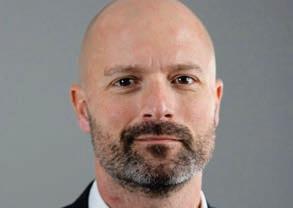
“We hired an expert, Gallagher
See BUDGET on page 13
Charlotte’s local cannabis control commission — who are also members of the selectboard — denied an application for a mixed cultivator tier 1 cannabis license Monday for Vermont Cultivars LLC in defiance of state guidance, citing disagreement with the town zoning administrator’s issuance of a local permit for the cannabis producer.
After initially postponing the original decision to OK the application at the Feb. 13 selectboard meeting, Keith Oborne, the town’s zoning administrator, determined that because a medical cannabis growing operation was previously permitted at that same site, he treated that as a permitted use and issued a permit to the grower
Because of this “grandfathered” use on the site, it’s a simpler process than conditional use review before the development review board that’s usually required, because Charlotte does not yet have land use regulations in place to govern the cannabis market, explained town planner Larry Lewack,

The planning commission is currently finalizing new cannabis regulations that will be presented at a public hearing on March 23.
During Monday’s meeting, cannabis control commission members discussed several issues they had with Oborne’s decision. But town administrator Dean Bloch reminded members, “You may not agree with that, but I don’t think that matters, a zoning permit was issued. That stands. It wasn’t appealed. So, the role of the local cannabis control commission is to accept that permit and refer the application back to the state to say the zoning permit has been issued.”
Commission member Frank Tenney said one of his main concerns was that “it did not go through site plan. The only thing that’s allowed without getting a site plan are dwellings, forestry and agriculture. If it’s treated like a business, every business in town that gets a permit has to go through site plan review.”
“I want to make sure that we’re following
local rules,” he continued.
Bloch responded, “What I would want to guard against is opening us to liability that we’re not following the appropriate process. I know you’re trying to follow the process, but I don’t think we have any say in it after the zoning permit has been issued.”
Lewack explained in a separate conversation that while the inside portion of this cultivation operation may be permitted use, some of the concerns from the local cannabis control commission may have stemmed from what will happen with the 1,000 square feet earmarked for outdoor growing in the town’s industrial district.
“What happens inside the building as a use — I agreed with Keith — is appropriate to grandfather because it’s almost identical to the previous use,” Lewack said. “But what this particular business wants to do is also have an outdoor grow, where they’re going to have a patch of up to 1,000 square feet of plants.”
According to Lewack, although the state — through Act 158 — exempts outdoor grows up to 1,000 square feet from municipal permitting, he said, “by the state’s own measurement, you can only get a tier 1 outdoor grow license if it’s happening on land which is a farm that is following required agricultural practices. By definition, that’s not going to be the case found in the industrial district.”
Despite the concerns during the halfhour-long conversation, Nellie Marvel, the outreach and education manager for the state’s Cannabis Control Board, explained in an email that a town only has the authority to approve or deny an application based on the three areas that they have the authority to regulate: zoning, public nuisance and signage. If an application meets those requirements and has the required permits for the town they’re operating in, then the town doesn’t have the grounds to deny a license.
“(The application) went through the town process whether or not you like that process,” town administrator Dean Bloch said at the meeting.
Nonetheless, when a motion was reluc-
tantly made and seconded, members unanimously voted the project down.
Commission member Lewis Mudge questioned the value of even having a local cannabis control board.
“I guess what I object to is the sort of performative aspect of why we are voting,” Mudge said. “I mean, this permit has been approved, the horse has already left the barn. Yeah, we’re having this conversation, but I’m still baffled by the fact that we can’t actually say where it is. That’s still just weird.”
Marvel explained that the reason the state’s control board gives such limited information to town during the application process is for the grower’s confidentiality and privacy purposes. “For instance, a lot of our cultivators have expressed concerns to us, rightly so. There have been instances in other states where their addresses get published, and then come September when their crop is flowering and about ready for harvest people have seen their crops stolen before they’ve had a chance to actually harvest and reap the benefits of their labor,” she said.
It remains unclear exactly what the town’s next steps are, but Bloch confirmed that with-

out the local cannabis control commission’s approval of the license, the cultivator cannot start cultivation.
“He may, however, make preparations in accordance with the zoning permit, though this would be at risk that the license may not get approved,” he said.
When asked when the town will notify the state that the application was denied, Bloch said, “We’re probably going to be checking with the town attorney on that.”
Jim Faulkner, chair of the selectboard and commission member, could not be reached for comment.
“I think the selectboard doesn’t want to place itself above the interests of neighbors,” Lewack said. “I don’t know to what extent neighbors will be concerned about this outdoor cultivation proposed, but I think they should have their due process. If that was a driver for the (local cannabis control commission’s) decision that people have due process and have an opportunity to weigh in on this before it gets the green light, I think that’s completely legit. That’s what the town’s effort to create these new cannabis standards is all about.”
A new bill would move the legal age for all marriages in Vermont to 18 years old, the age of consent, mirroring moves in other state legislatures this year to ban child marriage. Under existing law, minors 16 years of age and older can legally marry in Vermont with the written consent of one parent.

“Children need to grow up safe and strong, educated and ready for the future,” Rep. Carol Ode, D-Burlington, the sponsor of the bill, told the House Judiciary Committee on Feb. 16. “They deserve to be free from marriage before they grow up.”
If the bill, H.148, is passed, Vermont would be only the seventh state to ban child marriage, joining neighboring New York and Massachusetts in doing so.
“What we don’t want is for Vermont to become a destination state for child marriage,” said Marcie Hambrick, director of research and programs for child sexual abuse at the nonprofit Prevent Child Abuse Vermont. “I don’t think that’s what our state is about.”
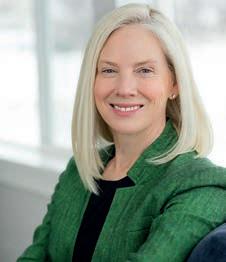
The U.S. State Department labels forced marriages, especially involving minors, as a human rights abuse. Yet, child marriage remains legal in 43 states, some of which have no minimum age to marry at all.
This isn’t the first time the Legislature has considered measures to raise the legal age of marriage. Last year, Ode sponsored H.631, a bill that would have raised the marriage age to 18, but the measure timed out in committee.
Just under 300 children were married
See BILL on page 12
An unspecified threat reported from an inbound flight brought several emergency response teams to the Burlington International Airport on Sunday.
Around 4 p.m., an inbound flight from Newark, N.J., reported a threat to air traffic control, and the plane was directed to an area away from the terminal, according to Nic Longo, the airport’s director of aviation.
The plane was searched but nothing suspicious was found.
Crews from South Burlington, Burlington and the Vermont State Police responded to the scene. There were more than 60 passengers aboard to plane.
One passenger, Vermont Senate President Pro Tempore Phil Baruth, D-Chittenden South, said officials told passengers that a note had been found on the plane saying there was an explosive device aboard.

According to Baruth, bomb-sniffing dogs boarded the plane, which had been parked on the tarmac.
Passengers were eventually allowed off the plane and were
directed to a hangar until a security assessment was complete, Baruth said. He said baggage and personal belongings became available around 8 p.m.
According to acting Burlington Police Chief Jon Murad, the Federal Bureau of Investigation is taking the lead in the investigation because the incident began in federal air space.
Officials did not specify the exact nature of the threat but, Longo said, there’s “no reason to believe that this is anything but an isolated incident.”
VTDigger contributed to this report.



Total incidents: 36
Traffic stops: 13
Arrests: 4
March 6 at 1 p.m. an officer responded to Shelburne to assist officers there with a juvenile issue.
March 6 at 3:50 p.m., a welfare check on Hillview Terrace was conducted.
March 6 at 5 p.m., a stranded motorist was assisted on Charlotte Road.
March 8 at 10:08 a.m., officers responded to Kailey’s Way for the report of a domestic dispute.
Natalie Davis, 29 of Hinesburg, was arrested for aggravated domestic assault and released on conditions. Etienne Carpenter, 29 of Hinesburg, was arrested for aggravated domestic assault and interference with access to emergency services. Carpenter was held on a warrant for failure to appear in court.
March 8 at 8:20 p.m., an officer responded to a single-car crash on Charlotte Road. The operator, Michael Dunbar, 48 of Charlotte was charged with driving under the influence and impeding an officer.
March 9 at 7:53 a.m., a person was assisted with fingerprinting for employment purposes.
March 9 at 12:50 p.m., a fraud was reported and investigated.
March 9 at 3:30 p.m., an officer
responded to North Road for the report of a loose dog in the roadway.
March 9 at 3:35 p.m., officers investigated the report of a theft of property on Bear Lane.
March 10 at 7:21 a.m., the report of suspicious activity at CVU was investigated.
On Mar, 10 at 4 p.m., police performed fingerprinting services for a resident.
March 10 at 4:35 p.m., officers assisted with a medical incident on Jourdan Street.
March 10 at 8:40 p.m., officers responded to Shelburne to assist with a reported assault case.
March 11 at 5:30 a.m., officers were advised of a single-car crash on Hollow Road.
March 11 at 9:45 a.m., a welfare check on Hayden Hill Road was conducted.
March 11 at 11:40 a.m., officers responded to Taproot Farm Lane for the report of a domes-
tic dispute. There, Matthew Hinton, 39 of Milton, was arrested for domestic assault. March 11 at 2:10 p.m., a welfare check on North Road was conducted.
March 13 at 4:45 p.m., officers responded to Richmond Road for a juvenile issue.
March 13 at 8:06 p.m., a welfare check on Shadow Lane was conducted.
Advertising Wendy Ewing wendy@shelburnenews.com (802) 985-3091 x12
Advertising Director Judy Kearns judy@otherpapersbvt.com (802) 864-6670 x21

Managing Editor Dylan Kelley dylan@stowereporter.com
News Editor Tommy Gardner
Staff Writers
Aaron Calvin Corey McDonald
Liberty Darr
Production Manager
Stephanie Manning stephanie@shelburnenews.com
Editor/Publisher Gregory Popa gpopa@stowereporter.com
Billing inquiries Leslie Lafountain leslie@stowereporter.com (802) 253-2101

Advertising submission deadline: Friday at 5 p.m. advertising@thecitizenvt.com classifieds@thecitizenvt.com
Editorial submission deadline: Friday at 5 p.m. news@thecitizenvt.com
Calendar submission deadline: Friday at 12 p.m. news@thecitizenvt.com
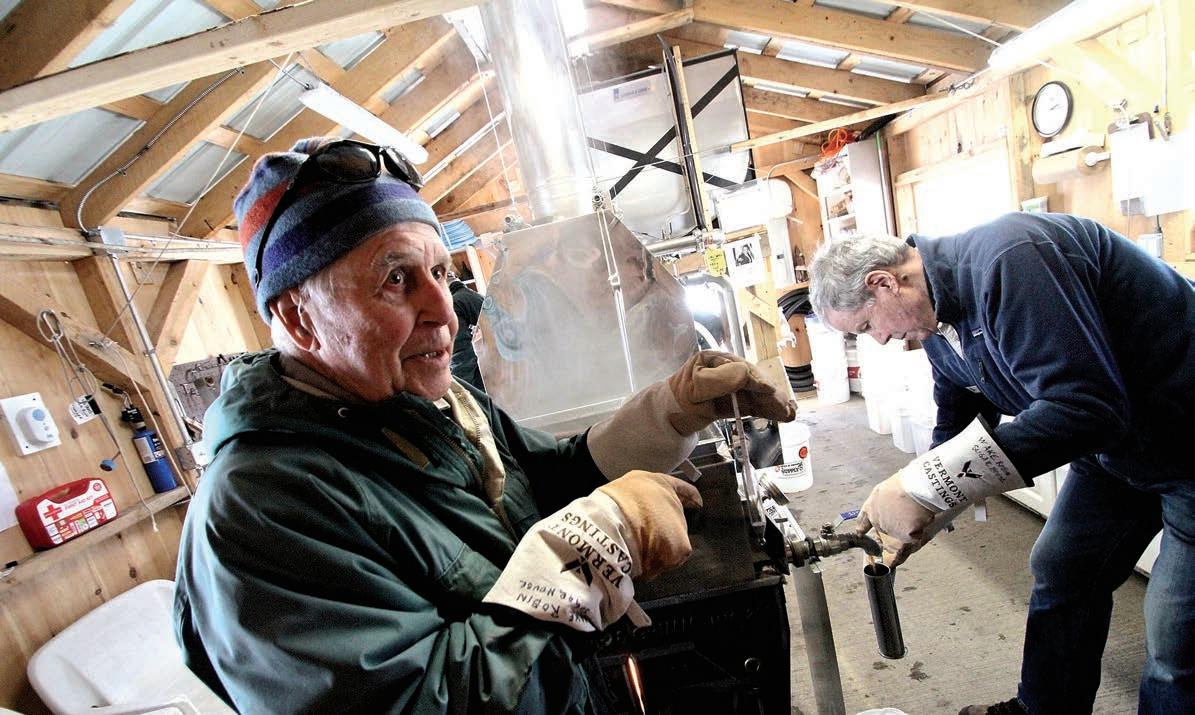
Contact: 1340 Williston Road South Burlington, VT 05403 (802) 985-3091
March 11, 11:14 p.m., Mark S. Taylor, 54, of Charlotte, was arrested for driving under the influence, first offense, after police stopped him on Route 7 and State Park Road for a moving violation.
Total incidents: 51;
Total, year to date: 86
Fires: 4
EMS: 29
Motor vehicle collisions: 3
Hazardous conditions: 1
Service calls: 1
Good intent calls: 1
False alarms: 1
6,as
he and his fellow volunteers enjoy a record year for production so far, given the warm-to-coldtemperature shifts. The
crew expects to boil through April. Blackmer is no stranger to the art and science of syrup making, producing the sweet stuff for decades in southern Vermont before moving to Shelburne. Volunteers each year take shifts, collecting sap and stoking the fire. As visitors stop by for a taste test, their designated cups live on the sugarhouse windowsills, awaiting their return and another sip.

Guest Perspective
During the early months of COVID-19, governors in New England states issued executive orders allowing municipalities to meet online so long as the public could attend remotely. The democratic benefits of this arrangement quickly became evident. According to a public official quoted in a 2020 study, the changes “made it a lot easier for residents who have other things to do, to be heard. People with family obligations, elder care, or child-care issues.”
The executive orders that prompted these changes, however, have long since expired. New England states have resorted to a patchwork of livestreams, short-term remote meeting requirements and, in some cases, reverted to pre-COVID-19 policies and in-person meetings only.
There’s a better way forward.
Permanent changes need to be made to state laws to require both in-person and remote access to government meetings. People with young children, health issues, disabilities, work commitments or other circumstances that prevent in-person attendance at these meetings are at risk of again being shut out of the democratic process. At the same time, there are benefits to in-person meetings that must continue along with this expanded access.
Now is an ideal time to contact your state representatives and make this need known. Sunshine Week is March 12-18 and is a celebration of open government and freedom of information. The sunshine reference is attributed to U.S. Supreme Court Justice Louis D. Brandeis who famously wrote that “sunlight is said to be the best of disinfectants.”
In other words, an informed citizenry is the best check against government corruption. We should use the occasion to demand the permanent changes necessary for all members of the public to effectively engage with the government and stay informed.
The 2020 study — published in the Journal of Civic Information and authored by Jodie Gil and Jonathan L. Wharton — involved nearly 100 municipalities in Connecticut following the state’s COVID19 emergency orders. It found that most of these municipalities experienced the same or increased participation during their public budget deliberations as they had previously.
While these towns also experienced learning curves and other unexpected challenges, the authors’ findings reinforce what
many of us have come to believe during the last three years: the public is more likely to participate in meetings when given multiple ways to do so.
Massachusetts lawmakers recently recognized this reality with legislation that could serve as a model for other states. The bill would apply to all executive branch agencies and municipal bodies subject to the state’s open meeting law. It phases in over seven years a requirement that they meet in person and also provide remote access and participation but demands swift compliance by state agencies and elected municipal bodies.
Non-elected municipal bodies with logistical or budgetary concerns can apply for hardship waivers. The legislation even creates a trust fund that will financially support those needing assistance. The waivers, however, are available only until 2030. There must be universal compliance by that time.

While each state has its own local considerations, there’s no reason why other open meeting laws cannot ultimately require hybrid access. Don’t know what legislation is introduced in your state? Use the legislation trackers at nefac.org/foiguide.
Remote meeting technology is becoming more prevalent, less expensive and greatly needed by citizens unable to attend in person. At the very least, open meeting laws should be changed to incorporate:
• Hybrid access: The public needs in-person access to government meetings along with the ability to attend and participate remotely. Both forms of access are critical. While remote meetings will make government accessible to those who cannot otherwise attend, citizens still need face-to-face time with their representatives without their commentary being muted or disconnected from a Zoom line.
• Hard deadline: The goal is to have all public bodies meeting in a hybrid form. The ease of reaching this goal will vary from one government agency to the next. States should set a clear and hard deadline for all government bodies to comply, taking into consideration challenges such as staffing, funding and logistics.
• Funding: A common argument against hybrid meetings is the cost of the required equipment and technology. While these costs have decreased significantly, they can still impose a burden on small towns with limited funding and staffing. States should earmark funding specifically for the purpose of hybrid meetings and help those munic-
To the Editor:
My daughter opened the paper in anticipation today that she’d see an article about the Champlain Valley Union girls’ basketball team’s championship game from March 3.
When she saw no mention and just a picture and headline of the boys run to the finals, she closed it and said, “typical. Everyone only really cares about the boys’ teams.”
This has always been noticed in our

house that the gym is filled with fans for the boys’ games, but some girls’ games will barely have the student section filled. Seeing the lack of mention in the paper was disheartening and hopefully an oversight.
I would hope that the next edition would highlight the girls’ win and, hopefully after tonight, the boys’ win, as well!
(Editor’s note: Both title wins will be covered in our March 23 edition.)
Marie Ayer Hinesburg
All new dresses for all yourJustin Silverman Justin Silverman
Blaming public schools for the declining quality of their graduates is a lot like firing a high school coach after a few losing seasons. Yes, sometimes it’s the coach’s fault, but more often the problem lies with his players’ deficient skills or insufficient effort.
Critics insist schools need to change to equip students with 21st-century skills, but the truth is too many graduates lack skills for any century, like reading and writing.
Anybody who thinks the solution lies in making schools more fun, more hands-on, or more student-centered, or that students would learn if we’d only let them use their smartphones to consult their friend in the next row, has missed the fact that reform-minded bright ideas, including cooperatively sharing their work and answers, have been contributing to the national academic decline since before there were smart-
phones.
Advocates, primarily but not exclusively on the political right, prescribe charter schools and vouchers as solutions. Charter schools are essentially private schools that receive public funding. Vouchers are tuition credits that parents can spend at the school of their choice.
It’s only reasonable to wonder if my doubts about school choice are prompted by self-interest. After all, where would teachers like me find jobs if students started attending other kinds of schools? The obvious answer is many of us would wind up working at other kinds of schools. The laughable part about any wholesale plan to replace mediocre teachers is nobody ever gets terribly practical about where the replacements would come from.
Some reformers propose hiring real-world experts. Let engineers teach science and accountants teach math. Journalists can run English classes, lawyers can take the helm in civics and diplomats can drill students in French.
Right.
There’s a reason many realworld types don’t teach in public schools. It isn’t because no one will give them permission. It’s because they don’t want to do so.
Even if you could somehow entice working professionals into America’s classrooms, that wouldn’t guarantee a better crop of teachers. A decade ago, a brokerage firm aired a commercial depicting an ex-businessman who’d amassed enough of a stock portfolio to be able to retire and live on a teacher’s salary. He told his new high school class how thrilled he was to be there and how he was going to make learning fun, and how they were all going to have a good time.
They stopped filming just before his students ate him for breakfast.
Socrates didn’t hold a teaching certificate. A license doesn’t guarantee that a teacher, or a doctor or
an electrician, is good, only that he’s met some minimum requirements. We need to decide if those minimum standards are worth maintaining and documenting.
If they aren’t, then let’s eliminate them in every school, not just charter schools. Why should any classroom be saddled with regulations that hamper education? On the other hand, if the rules are worthwhile, then they should apply to every institution.
Private schools can already set their own standards and write their own regulations. Parents can already decide how and where they want their children educated. If parents want to enroll their children in a private school that doesn’t require teaching certifi-
cates, or one that focuses on the arts or accents religion, that is and should be their prerogative.
The fact is parents have always had school choice.
Charter schools and vouchers are all about having the public pay for those choices. Why should we?
Conservatives like to talk about education as if it were a business, but they’ve forgotten who the customer is.
The customer isn’t a student. The customer isn’t the student’s parents. The customers are the citizens who pay the bills.
Activists across the nation increasingly lobby for parent-trig-
See BERGER on page 7
Local businesses and restaurants need your support more than ever. Whether you visit stores, get delivery or shop online, keep your spending local and keep your community healthy.
Newspapers are LOCAL. We are dedicated to keeping you informed, safe and connected and care about the issues that are important to our neighbors, our schools and our businesses.
Local businesses and restaurants need your support more than ever. Whether you visit stores, get delivery or shop online, keep your spending local and keep your community healthy.
When you support your local newspaper, you support your community.
Newspapers are LOCAL. We are dedicated to keeping you informed, safe and connected and care about the issues that are important to our neighbors, our schools and our businesses.
I hope everyone enjoyed another Town Meeting Day reconnecting with neighbors. This week marks the mid-point of the legislative session that we call crossover when the House must get its priority bills over to the Senate and vice versa so both chambers can fully consider the details. Here are some highlights of what is moving from one body to the other:
• Housing
lines overlapping permitting processes to bring down costs and make more workforce homes available. With 24,000 open jobs and fewer than 1,000 housing listings, we will not meet climate, health care, child care or other policy goals without creating more opportunities for Vermonters to live in safe, warm affordable homes close to where they work.
• Retirement security
tax to meet this critical need.
• Gun safety
We are looking at several common-sense gun safety provisions and hoping to find common ground with the governor. One particularly important to me is closing the loophole that allows someone with an abuse or extreme risk protection order against them to place their guns in the hands of a family member instead of having them stored in a state-sanctioned facility for the duration of the order. Some of the devastating mass shootings in this country involve this kind of retrieval of guns from a non-secure location.
When you support your local newspaper, you support your community.
Contact Wendy Ewing at wendy@shelburnenews.com or 985-3091
As chair of Senate Committee on Economic Development, Housing and General Affairs, I am proud of its work on S.100, the Housing Opportunities Made for Everyone (HOME) bill. It was voted out of committee unanimously and is currently in the Senate natural resources committee, expected to advance with consideration for the balance between housing and conservation. Both appropriations committees will also weigh in, as we continue to make historic investments in housing and municipal infrastructure with recovery funds and new federal dollars.
The HOME bill promotes multi-family housing and stream-
The committee is working with the state’s treasurer to advance a new program called VT Saves. Following the lead of 12 other states, we would create an opt-out voluntary retirement savings program for all Vermonters who do not currently have a retirement savings plan, currently about half of working people in Vermont.
• Child care
Another piece of workforce equation is child care. We commissioned a study of the costs to provide early educators with competitive wages and benefits, and we are looking at a roughly $200 million price tag to support their economic well-being while ensuring most parents pay no more than 10 percent of their income toward child care. A coalition of business leaders are advocating for 1 percent on the payroll
I hope this helps you stay informed on some of the major work we have ahead of us this session. I look forward to your feedback, even if I’m a little slower to reply. We are likely to adjourn in mid-May, and my due date is May 10, so keep me in your thoughts as the session progresses and I try to finish the people’s work before my baby — and Shelburne’s newest resident — arrives.
Kesha Ram Hinsdale, a Democrat from Shelburne, represents the towns of South Burlington, Shelburne, Charlotte, Hinesburg, Milton, Burlington, St. George, Westford, Underhill, Jericho, Richmond, Winooski, Williston, Essex and Bolton in the Legislature.

Parents can already decide how and where they want their children educated.

 BONNIE KIRN DONAHUE UNIVERSITY OF VERMONT EXTENSION
BONNIE KIRN DONAHUE UNIVERSITY OF VERMONT EXTENSION
Winter in New England brings snow, ice and salt.
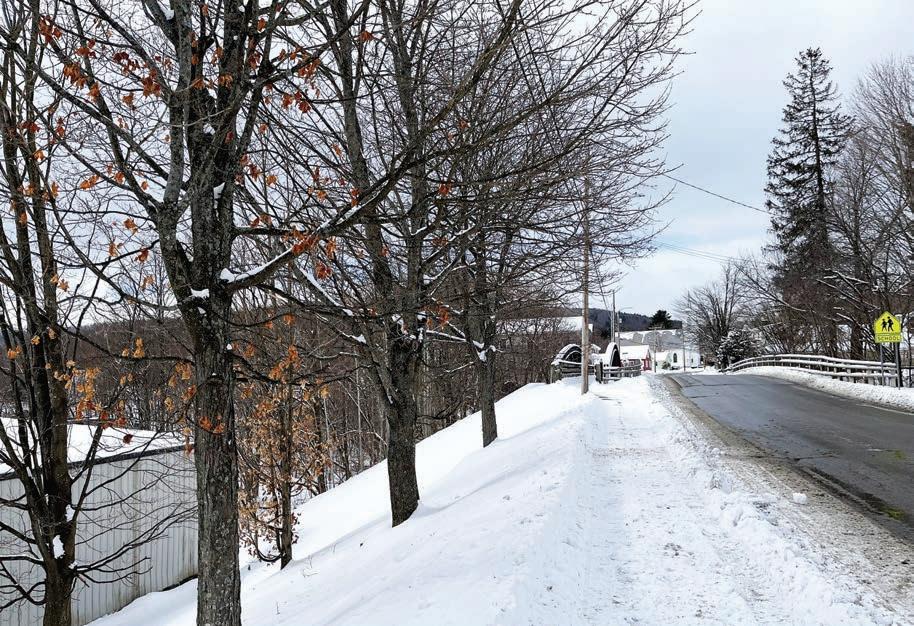
Salt can be a great asset in the winter for deicing roads and walkways. It prevents ice from forming by lowering the freezing point of water, creating safer surfaces for people to walk and drive on.
However, salt can have a detrimental impact on woody and herbaceous plants in the landscape, impacting them in several ways.
Salt spray that splashes off salted surfaces can coat the outside of a plant’s stems or leaves. It is corrosive and can burn leaves, stems and even buds, impacting flowering in the spring.
Salt on the soil surface can soak into the soil and become absorbed by plants. Once absorbed, it pulls moisture from plant tissues and dehydrates plants from the inside.
Luckily, there are things that we can do to mitigate these impacts.
First, for existing garden beds that are close to salted roads or sidewalks, flushing the soil with water in the spring is one way to clear salty build-up from the winter. Spring rains may provide enough water to leach the salt from




BERGER
continued from page 6
ger laws. These statutes empower a school’s parents to vote to close a school, turn it into a charter school, fire teachers and principals and petition to make significant changes in school policies. Notice that only parents get a vote, not the citizens who pay for the schools.
Nearly four hundred years ago, the Puritans established the first tax-supported public school system. Their intention was to teach their children to read the Bible so they could avoid the Devil’s snares. They cared about each child’s welfare, but they had their society’s best interest in mind. They were willing to spend public funds on instruction they deemed valuable for their community.
Today, public schools have a mission that society considers equally vital. It’s a mission we inherited from Thomas Jefferson. We’re working to prepare the heirs of the Republic.
That means passing along the body of knowledge and skill that we consider worthwhile. It doesn’t mean writing a blank check to anybody. It doesn’t mean




the soil naturally, but watering the plant bed one or two times in a dry spring might be all that is needed. Be careful not to overwater the bed to avoid soil erosion.
Second, when selecting sites for planting new garden beds or trees, it is critical to consider potential salt exposure. Planting trees, shrubs and perennials near salted surfaces creates the possibility that plants will struggle, so consider what is adjacent to your garden bed or tree.

Finally, in areas where you can’t avoid salt exposure, select plants that are more tolerant of salt.
For trees, several native oak species have some salt tolerance, including white oak, red oak and swamp white oak. Native shrubs such as winterberry, black chokeberry and nannyberry also are known to have some salt tolerance.

Perennials such as daylilies, catmint and yarrow perform well with exposure to salt.




Research on salt tolerance of plants varies, so look for Cooperative Extension resources in your area online or ask your local nursery or greenhouse grower for advice.
Salt is a reality of winter, but it doesn’t need to ruin your garden in the spring. Try these tips and see
how you can have the best of both worlds.
paying the bills for every alternative school that cartwheels across the school-reform stage. It means funding schools that satisfy society’s criteria and goals. Parents are welcome within the limits of relevant law to take advantage of the schools that society offers. They’re welcome to take part in an orderly discussion and debate about those schools — no threats, no fists, no guns. Beyond that, we extend to any parent the liberty to choose another educational philosophy, curriculum and institution.
We don’t build public roads to suit each individual motorist’s personal destination. If a school’s program doesn’t promote the public good, doesn’t teach students what society wants them to know, then we the public shouldn’t be expected to pay for it.
Any school that receives public funds should be answerable to the voting, tax-paying public by an elected schoolboard. Charter schools are governed by private boards of directors and therefore aren’t directly accountable to the public. Vouchers similarly require
us to pay for schools over which we have little or no control.
There’s more than one way to educate children, and some public schools admittedly are doing less than satisfactory work. There’s room for improvement, including the adoption of some provisions of laws like Florida’s parental rights statute. For example, parents should be able to find out what their children will be learning.

Bear in mind the following the next time you’re inclined to claim your parental rights at school: Parents are sovereign in their children’s lives but not in the lives of other people’s children.
Parental choice usually doesn’t improve schools.
Parents already have school choice. It’s called voting in school board elections.
We need to stop talking about public education’s problems as if someone else were the public.
Peter Berger has taught English and history for 30 years. Poor Elijah would be pleased to answer letters addressed to him in care of the editor.
Charlotte resident Nancy Warren has joined Coldwell Banker Hickok & Boardman. Warren has more than 16 years of experience in the real estate industry. Warren specializes in not only connecting clients with their dream home but also the community where they will live.
The Age Well meal pickup for Thursday, March 16, is from 10 to 11 a.m. at the Charlotte Senior Center features beef round, boiled potatoes, cabbage and carrots in beef stock, wheat roll with butter, leprechaun cake with frosting and milk.
You must pre-register by the prior Monday with Kerrie Pughe, 802-425-6345 or kpughe@charlotteseniorcentervt.org.
The meal on Thursday, March 23 features roast pork with sauce, mashed potatoes, peas and onion, wheat dinner roll with butter, oatmeal raisin cookie and milk.
The meal on Thursday, March 30 features turkey burger with vegetable gravy, mashed potatoes, Brussel sprouts, wheat roll with butter, peach Craisin crisp and milk.
The meal on Thursday, April 6

features sweet-and-sour pork with vegetable sauce, brown rice with lentils and vegetables, green beans, wheat bread with butter, Easter cake with icing and milk.
The suggested donation is $5. Check the website for last-minute cancellations at bit.ly/3FfyLMb
On Sunday, March 19 at 2 p.m. at the Ethan Allen Homestead, Dr. Elise Guyette introduces the lives and work of Black trailblazers in early Burlington history whose stories have been absent from the historical narratives as the town changed from village to the Queen City.
Attend in person at the Homestead Museum, register remotely at bit.ly/4204db8, or by email at ethanallenhomestead@gmail.com or phone at 802-865-4556.
Meet your legislators on Monday, March 27, 4 to 5:30 p.m., in the Shelburne Pierson Library community room.
Representatives Jessica Brumsted and Kate Lalley, along with senators Thomas Chittenden, Virginia Lyons and Kesha Ram Hinsdale, meet the fourth Monday
Promote your program in our Summer Camps guide for targeted exposure to a local audience of kids and parents as they make plans for the upcoming summer season. This advertising section is a go-to guide for summer camp and recreation researchers, making it the ideal place to outline your offerings and secure more early enrollments.
Publication Dates: March 9 and April 6
Deadlines: Thursdays before each issue
Contact: Stowe Reporter/News & Citizen at 802-253-2101, Shelburne News/The Citizen at 802-985-3091 or The Other Paper at 802-864-6670 for information or to advertise your camp (ask about multi-paper, half-price color and Burlington Area Newspaper Group deals).

of every month at the Pierson library.
The Charlotte Shelburne Hinesburg Rotary will host an all-youcan-eat pie for breakfast event on Saturday, March 18, 8 a.m. to noon,
at the Shelburne Town Hall.
A wide variety of sweet and savory pies are available from PoorHouse Pies in Underhill and homemade selections by Rotary members. Entertainment will be offered by Shady Rill and McFadden Irish Dance Academy. Recommendation is $10 for adults and $5 for children.

Student wildlife art contest deadline is March 17
The deadline to apply for the second annual Vermont Student Wildlife Art Contest is Friday, March 17.
The prize for first place is $1,000. Nine other cash awards will go directly to winning artists in grades seven through 12 who submit two-dimensional art in any medium and depicting any species of Vermont wildlife.
An exhibition of the top 40 will be held in late April at the Highland Center for the Arts in Greensboro. Rules, information and online application form are at vtwildlifeeducationfund.org.
Growing Together Community Garden, sponsored by the Community Alliance Church, is an organic, raised bed gardening site open to all. Located on a rise next to the Community Alliance Church on Pond Road in Hinesburg, the cost for a 4x12 bed plot is $35 for the first year, $20 in subsequent years and includes a water source and guidance from a UVM Extension master gardener.
If you have questions or would like a registration form, call 482-3372, or email larcredsox@ gmavt.net.
To learn more or reserve your space, talk to us today!

The Armand Poulin Memorial Green Up Day poster art contest is a fun project for many art classes in January when there is usually plenty of snow on the ground. It
continued from page 8
On Sunday, March 19, at 2 p.m., Vermont state archaeologist Jess Robinson, a native Burlingtonian and graduate of University of Vermont, with advanced degrees from the University of Kent and University of Albany, will speak in the Fletcher Free Library’s Pickering Room about the native people who lived in the region pre-European contact.
Robinson will share insights about gained through exploration of archaeological sites and discovered artifacts. The event is free with elevator access to the upper floor.
Give the lifesaving gift of blood at the Shelburne community blood drive on Tuesday, March 21 from noon to 5 p.m. at the St. Catherine of Siena parish hall in Shelburne. This blood drive is our way of giving neighbors an opportunity to help save lives.
gives kids an opportunity to think about the spring ahead and how they can influence the litter problem as it begins to creep out of the snowbanks.
To give, call 1-800-733-2767 or visit http://RedCrossBlood.org and enter Shelburne to schedule an appointment.
On Saturday, April 1, at 9 a.m., the Hinesburg Community Resource Center hosts a spring kids’ clothing and book swap at the United Church of Hinesburg’s Osborne Parish Hall.
All gently used children’s clothing, sized infant to 14, and children’s books from toddler to middle-school reading levels are accepted. Drop off clothing and books at the parish hall on Friday, March 31, from noon to 8 p.m. Donations may also be dropped off at Carpenter-Carse Library from Monday, March 27, to Friday, March 31.
No toys and no drop-offs are accepted on the day of the swap. For more information, call or email Alexandra Koncewicz at 802-4824946 or koncewicz@hinesburgresource.org.
“Every year we see bright and sunny happy images — how Green Up Day makes us feel — and dark and dreary images, the what-if-Green-Up-Day did not exist scenario,” Green Up executive director Kate Alberghini said. “Usually, we see around 200-250 entries. This year we had 654. It is fantastic to see student engagement, in all age groups, on the rise. They are genuinely becoming more aware, more concerned and more involved in environmental stewardship.”
Longtime judges David Schutz and Hale Ritchie had their work cut out for them in reviewing the art in every medium, from crayons to watercolors. The overall contest winner, whose art will be featured on the Green Up Day posters, is Penelope, a fifth grader from Ludlow. The grade nine to 12 category winner is Amelie, a tenth grader from Dorset; the grade five to eight winner is Audrey, an eighth grader from Shelburne; and the winner for grades kindergarten to fourth is Gabriel, fourth grade of
Underhill.
In addition to artwork, there is a writing contest. From essays to poems, kids relay their concerns and love for Green Up Day. The winner of the writing contest is Juliette, an eighth grader from Montpelier.
Cash prizes are awarded to each winner.
Green Up Day this year is Saturday, May 6.
To learn how to get involved with Green Up Vermont go to greenupvermont.org.

Ready for spring? Then join the Rethink Runoff stream team in a rain barrel workshop and build and paint a rain barrel in preparation for warmer weather.
By installing a rain barrel you can save water and money and help local streams at the same time. The stream team is hosting a workshop to teach you how to build, paint, install and maintain your own rain barrel.
When it rains, stormwater moves quickly over impervious surfaces such as buildings and roads, picking up pollutants like nutrients, sediment, oil, chemicals, road salt and metals. By capturing stormwater before it flows over roads urban residents can help decrease the amount of pollutants entering Lake Champlain.
The water you save in a rain barrel can be used for watering lawns and flower gardens and washing your car or tools. Rain barrels help decrease runoff to Lake Champlain by capturing and holding rain water during a storm, and that means cleaner water for everyone.
Two workshops will be held on Friday, April 14, at the Public Works Facility, 291 Avenue A, Williston, 10 a.m.-noon and 1-3 p.m.
To sign up, visit bit. ly/3T7q24L.
Priority will be given to Shelburne residents, but residents of other towns (see list below) can register, and their names will be added to a wait list. The cost is $40, which covers the cost of supplies.
Email Adelaide Dumm with questions at adelaide@winooskinrcd. org.
Rethink Runoff, a program managed by the Chittenden County Regional Planning Commission, is an ongoing public outreach effort to reduce dirt and pollutants in stormwater runoff in the Lake Champlain Basin.
The Stream Team is a project to engage citizens across a nine-municipality area — Burlington, Essex, Essex Junction, Milton, Shelburne, South Burlington, Williston, Colchester and Winooski — to implement projects that reduce nonpoint source pollution and stormwater volume at the local level. The program is coordinated by the Winooski Natural Resources Conservation District.
Madeline Haydock of Charlotte has been named to St. Lawrence University’s dean’s list for the fall 2022 semester. Haydock is a member of the Class of 2026 and attended Champlain Valley Union High School.
Julia Daggett of Hinesburg made Emmanuel College’s dean’s list for the fall semester.
Sam Sturim of Charlotte was named to the dean’s list at Tufts University for the fall semester.
The following students were named to the dean’s list at Rochester Institute of Technology for the fall semester: Cole Rehkugler of Charlotte, who is in the mechanical engineering technology program; and Max Barron of Hinesburg, who is in the mechanical engineering program.
Sophie Yarwood of Hinesburg was named to Clark University’s fall 2022 dean’s list.
Corey Ryan of Hinesburg made the fall dean’s list at Vermont Tech.
Claire Smith of Hinesburg, a biology and health major at Grove City College from Hinesburg, was named to the dean’s list with distinction for the fall semester. Smith is a 2019 graduate of Champlain Valley Union High School and is the daughter of Carol and Kevin Smith.
Stephen Harlow of Hinesburg graduated with a bachelor’s degree in exercise science from Castleton University in December.
Hannah Cleveland of Charlotte earned dean’s list honors at The University of Tampa for the fall semester. Cleveland is majoring in applied sociology.
Caleb Nye of Hinesburg was named to the dean’s list at Endicott College for the fall semester. He is majoring in criminal justice and is the son of Amber Nye and William Nye.
Emma Bissonette and Abby Ferrara, both of Hinesburg, were named to the University of Rhode Island fall 2022 dean’s list.
Angela Fortin of Charlotte was named to dean’s list for the fall semester at Quinnipiac University:
Sophie Pidgeon of Charlotte and Trinity Nye were named to the dean’s list for the fall semester at the University of New England.
The following students have been named to the dean’s list for the fall semester at the University of Vermont from Charlotte: Skyler Heininger, biomedical engineering and computer science; Henry Bijur, neuroscience; Alyssana Lasek, biological science; Thomas Wright, mechanical engineering; Henry Lunde, environmental sciences; Seamus Higgins, chemistry; Olivia Hagios, English; and Antonio Pugliese, English.
Charlotte resident Cole Boffa was named to the president’s list at James Madison University for the fall 2022 semester. Boffa is majoring in industrial design.
Vladislav Moore of Charlotte was named to the fall dean’s list at Community College of Vermont.
The following students have been named to the dean’s list for the fall semester at the University of Vermont from Hinesburg: Zoe Prue, biological science; Peter Hyams, environmental sciences; Ashton Barbeau, biological science; Olivia Morton, biology; Jake Potter, history; Mia Twarog, psychological science; Andre Eastman, business administration; Harper Mead, elementary
education; Jacob Ashe, exercise science; Julia Hillier, exercise science; Lena Heinrich, zoology; and Michaela Buscher, business administration.
Wiley Simard of Charlotte was recently named to the Castleton University president’s list for the fall semester.
Madeline Baker and Samantha Haviland, both of Hinesburg were named to the Southern New Hampshire University fall semester president’s list.
Deona Proulx of Hinesburg was named to the Southern New Hampshire University fall semester dean’s list.
Mason Otley of Charlotte was named to the dean’s list at Lehigh University for the fall 2022 semester.
Graham Perry Coates-Farley of Hinesburg was named to Clarkson University’s dean’s list for the fall. The junior is majoring in computer engineering.
The following students graduated from the University of Vermont in May 2022 with bachelor’s degrees: Grace Slauterbeck of Charlotte graduated with a bachelor’s degree in political science; Alice Drew of Hinesburg, environmental studies; Evan Kaye of Hinesburg, political science; Lillian Miner of Hinesburg, political science; Annie Wernhoff of Hinesburg, psychological science; Ethan Leonard of Charlotte, computer science and information systems; Andrew Slauterbeck of Charlotte, magna cum laude, health sciences.; Jayce Slesar of Charlotte, data science; Kaileigh Doyle of Charlotte, anthropology; Sydney Vincent of Charlotte, nursing; Trevor McGlaflin of Charlotte, magna cum laude, computer science and information systems and business administration; William Burroughs of Hinesburg, community entrepreneurship; Rosalie LaCroix of Hinesburg, psychological science; Aidan May of Hinesburg, cum laude, biochemistry; Jack Morris of Hinesburg, economics; Lauren Polk of Hinesburg, biological science; Kendall Blanck of Hinesburg, biochemistry; Brandon Donahue of Charlotte, business administration; Sara Music of Hinesburg, business administration; Clayton Chisholm of Charlotte, computer science; Faith Thompson of Charlotte, early childhood preschool; Alex Nelson of Charlotte, College of Education and Social Services; Sage WhiteCloud of Charlotte, College of Education and Social Services; Samuel Comai of Charlotte, summa cum laude, secondary education — social science; and Carson Barbour of Hinesburg, mechanical engineering.
The following students graduated from the University of Vermont in May 2022 with advanced degrees: Samuel Raszka of Charlotte, Doctor of Medicine, Robert Larner M.D. College of Medicine; Danne Elbers of Charlotte, Doctor of Philosophy in complex systems and data science; Oliver Creech of Charlotte, master’s degree in English; Adam Polonski of Hinesburg, master’s degree in business administration; Chandler Jacobson of Hinesburg, master’s degree in business administration; Jessica Riley of Hinesburg, Master of Education in educational leadership; Katharine Mahoney of Charlotte, master’s degree in public health; Naomi Cunningham of Charlotte Master of Science in community development and applied economics; and Emily Raymond of Hinesburg, master’s degree in social work.
Alanna Pinard-Brace and Tristan Spearing of Stony Brook, N.Y., have announced their engagement.
Pinard-Brace graduated from Champlain Valley Union High School in 2015 and received a bachelor’s degree in music from the Crane School of Music at SUNY Potsdam in 2019 and a master’s degree in music education in 2020. She is a music educator.
She is the daughter of MaryBeth and Tony Pinard-Brace of Shelburne.
The following students graduated with bachelor’s degrees from the College of Charleston during its spring commencement: William Ravell, Hinesburg, communication; and Tyler Brooks, Hinesburg, biology.
Gregory Oles of Hinesburg earned an associate degree from the Community College of Vermont in spring 2022.
Sara McKenzie of Hinesburg earned an associate degree in nursing from Vermont Tech in spring 2022.
Lucy Mathews of Hinesburg earned a bachelor’s degree from St. Lawrence University in spring 2022. She graduated cum laude in history and government. Mathews attended Champlain Valley Union High School.
Moira Brown from Charlotte recently graduated from the College of William & Mary with a bachelor’s degree.
Hinesburg residents Jayden Grant (marketing) and Ann McCarter (nursing) graduated from Castleton University, Class of 2022.
Brenna Comeau from Hinesburg graduated from Ithaca College with a degree in
Spearing is director of residents at SUNY Stony Brook. He graduated Manlius Peeble Hill High School in 2015, and also received a bachelor’s degree in music from the Crane School of Music at SUNY Potsdam 2019, and a master’s degree in music education in 2020.
His parents live in Rockville, Md. The couple got engaged at Niagara Falls in August. A Sept. 28, 2024, wedding is planned at the Inn at Weathersfield in Vermont.

stage management in spring 2022.
Zaza Quatt of Hinesburg graduated from the Rochester Institute of Technology with a degree in illustration.
The following students graduated from Champlain College after the spring 2022 semester: James Fox, Charlotte, computer networking and cybersecurity; Suzannah Zimmerman, Charlotte, computer networking and cybersecurity; Dakota Siple, Hinesburg, early childhood/elementary education; and Noah Lee, Hinesburg, master’s degree in leadership.
Shelby Hanlon of Hinesburg graduated with a Doctor of Veterinary Medicine from the School of Veterinary Medicine, University of Wisconsin-Madison, in the spring of 2022.
Anna Cornish of Hinesburg graduated with a bachelor’s degree in international relations from Tufts University, spring 2022.
Genevie Lemieux of Charlotte graduated, cum laude, from the University of Rhode Island with a bachelor’s degree in public relations.
The Outside Story
Meghan McCarthy McPhaulOn my commute to the Northern Woodlands offices in Lyme, N.H., I pass a long-established osprey nest, perched atop a very tall electric tower next to Route 302. This location offers the ospreys a view of their surroundings and provides me with a view of the ospreys from the road. My early morning drive is brighter now, on the season’s edge, than it was in the heart of winter, and I have been craning my neck lately to get a look at the nest — hoping to see a raptor or two perched on its edge or soaring nearby.
It’s early still, I know, for the ospreys to return, but by now they’re likely on their way, flying north from their winter homes in South America, across the Caribbean to Cuba and from there to Florida, then along the East Coast and inland until they reach this nest. The chances are good that when I do spot the ospreys, it will be the same pair I’ve seen in past years here. Ospreys often form breeding pairs that last several years, although the male and female spend their winters separately.
“They take completely separate winter vacations, which maybe is the key to a long and successful marriage,” said Iain MacLeod, executive director of Squam Lakes Natural Science Center, who has been keeping tabs on osprey nests in New Hampshire’s Lakes Region for 25 years. “But they’ll come back to the nest year after year after year and reunite.”
Last spring, MacLeod witnessed the reunion of a pair that’s been together during the breeding months for at least 15 years. The female had already arrived by the time the male returned to perform what MacLeod calls “sky dancing,” a combination of vocalizations and aerial displays of hovering and swooping.
“As he dropped down to the nest, she flew to join him. The two of them sat on the nest together. He displayed submissive posture, where he kind of turns his back and droops his wings,” MacLeod said. “They mated within 20 minutes of reuniting, and then he went off and got her a fish, which is an important part of the courtship. Within 11 days, they were sitting on eggs.”
While many raptors build their nests in the shelter of overhanging branches, osprey nests tend to be high up and open to the elements – often on manmade structures, both those intended as nesting platforms and those meant for other purposes. These nests comprise a base of large sticks, topped by smaller sticks, with a lining of grass, moss, and bark to cushion the eggs. Ospreys add to their nests each breeding season, and a nest may grow to be as large as 6 feet across and several feet deep.
In New Hampshire, pairs typically produce three eggs each spring. The female is responsible for nearly all incubation, which lasts just over a month, and for tending to and protecting the chicks once they hatch. The male spends his time catching
fish for his mate and the chicks and guarding the nest from predators and intruding ospreys.
These raptors are purely fish eaters and have several adaptations for this lifestyle. Their long, narrow wings allow the birds to hover as they search for prey in the water below. They have long legs that can reach into the water and hooked talons to snatch fish. Ospreys have zygodactyl feet, meaning they have one reversible talon; while perched, three toes face forward, and one backward, but when they dive for a fish, the outer front toe pivots to provide a stronger grasp. Tiny barbs, called spicules, along the underside of their feet help ospreys hold slip-

pery, wriggling fish. If you catch a glimpse of an osprey flying with a fresh catch, look closely — the fish will be faced forward in those talons, reducing aerodynamic drag as the osprey flies.
As with many birds of prey, osprey populations were devastated by the use of DDT in the mid-20th century. Thirty years ago, when raptor biologist Chris Martin was starting out at New Hampshire Audubon, the only osprey nests in the state were in northeastern Coos County. Since then, the fish-eating birds have thrived and now nest throughout the state. When biologists stopped comprehensive tracking of nests in 2010, Martin said, there were more than 175 established
nests in New Hampshire.
One of those is the nest I pass, near the Ammonoosuc River and plenty of ponds and lakes for good fishing. I’m looking forward to the day, a bit later this spring, when I look up and see an osprey or two — back for another breeding season.
Meghan McCarthy McPhaul is the associate editor for Northern Woodlands. Illustration by Adelaide Murphy Tyrol. The Outside Story is assigned and edited by Northern Woodlands magazine and sponsored by the Wellborn Ecology Fund of the New Hampshire Charitable Foundation, nhcf.org.
ROSS
continued from page 1
serving clerk in more than a century — since at least 1900. She’s also served on the board of the Hinesburg Nursery School, on the town’s planning commission and was part of the Hinesburg Land Trust when it first got underway.
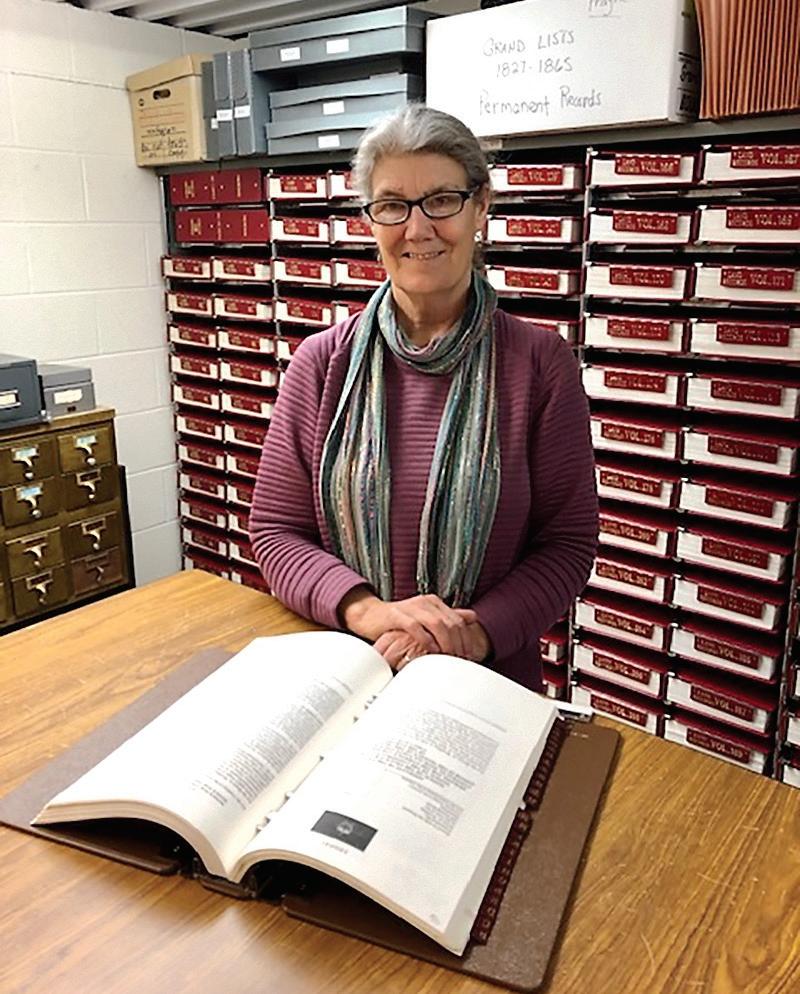
“It is with both sadness and anticipation that I move forward to the next chapter of my life,” she said. “I’ve had the distinct pleasure of holding one of the most rewarding jobs in Vermont — a job steeped in history and tradition.”
Ross has been the “face of business” in Hinesburg, selectboard chair Merrily Lovell said, “a warm and friendly face, one who treats every person with special respect and interest in a way that empowers us all.”
For 22 years, she’s greeted everybody in town seeking out dog licenses or marriage licenses, people begrudgingly going to pay their taxes or their water bills and myriad other requests.
“I’m definitely going to miss it. I’ll miss my colleagues, and I will miss just seeing everybody on a regular basis,” she said. “It will be an adjustment for sure, but I’m lucky to have a lot of good friends in the community.”
The town clerk is the official in town that, in more ways than the town’s state representative or even the selectboard, is “a face to the community,” former Vermont Rep. Bill Lippert said previously, “the person in office that most people

BILL
continued from page 2
in Vermont between 2000 and 2021, 80 percent of whom were girls, according to data from the Vermont Commission on Women.
Cary Brown, the commission’s
in the community interface with.”
It’s what she’ll miss the most, Ross said.
“People have just been really wonderful to get to know and no matter how small their request or problem might have been, it was the most satisfying thing,” she said. “I really, really enjoyed that.”
A native Vermont resident, Ross grew up in Manchester and then attended Middlebury College and later the University of Vermont, eventually settling in Hinesburg. After first serving as the town’s recreation coordinator, she moved on to the town clerk and town treasurer positions in October 2001.
Since then, she’s seen a lot of change — most recently, seeing COVID-19 completely disrupt Vermont’s town meeting day tradition.
Hinesburg, since the pandemic, has opted to use Australian ballot instead of the traditional in-person voice vote during annual meeting.
Hinesburg’s informational meeting “had fairly good attendance this year, considering there
wasn’t voting on anything,” she said. “But I do think it is partly an equity issue, to allow people the opportunity to vote on the budget — people who may have difficulties attending a meeting. As our population ages, I think it’s good to give those people an opportunity to vote by ballot.”
The town is set to see even more change in the coming years, as the town’s village center is expected to grow and transform as hundreds of new housing units come down the regulatory pike.
There’s some anxiety there, for sure — impacts on traffic congestion on Route 116, for example — and as a town gets larger, it gets more and more difficult to maintain those local traditions that are unique to Vermont towns, she said.
“On the positive side, it can be a good thing to infuse the town with new people who bring a new enthusiasm to volunteer committees and are looking for an opportunity to get involved.”
“People will hopefully be out and outside and be able to chat with people. I think that’s a better
form of growth to have ... I hope that that will help us maintain that community feeling.”
Ross will be replaced by Heather Roberts, the town’s assistant town clerk and treasurer, who ran
uncontested in this year’s election.
“As I pass the torch to the next town clerk and treasurer, I want to say thank you for your years of support, goodwill and good wishes for the future,” Ross said.
executive director, explained to the judiciary committee Feb. 16 that the common perception of child marriage being only between two teenagers is not always true. Almost
Award-winning group of community weeklies with offices in Stowe, Morrisville and South Burlington seeks a sales person. Ideal candidate should have a basic knowledge of the local towns, business and communities we serve. A proven track record in sales and an ability to offer topnotch customer service is a required. In addition to servicing established accounts, candidate must be able to generate sales from qualified leads as well as establish new ones. Our company offers health benefits, vacation time, and provides on the job training in newspapers sales. Generous base salary during training and ideal hours (few nights or weekends). If you possess these qualifications and would like to be considered, please send your resume and cover letter to: Bryan Meszkat at bryan@newsandcitizen.com.
half of the Vermont girls married underage were married to individuals four or more years older than them, typically grown men.
The commission ran an equity impact assessment on the policy to ensure it wasn’t negligent of any traditional cultural practices, especially with Vermont becoming an increased destination for migrants. The assessment found no adverse impacts on a racial or cultural level. Most of the victims of child marriage in the state were white, rural, lower-income girls, according to the assessment.
Brown shared national-level statistics with the committee about the benefits of raising the legal age. Women who wait until 18 years or older to marry are far more likely to graduate high school, attend and graduate college and are less likely to live in poverty, Brown said. Girls who marry before 18, on the other hand, are much more likely to be physically abused and suffer significantly higher health risks than those who marry in adulthood, Brown said. The Vermont Medical Society submitted a letter
to the committee in favor of the bill as well.
Also at the hearing Feb. 16 was Fraidy Reiss, a child marriage survivor and founder of the Unchained at Last nonprofit. She shared her personal experience being a child bride.
“I’m not going to sit here and argue that you wake up on your 18th birthday with newfound wisdom and maturity and the ability to choose a life partner,” Reiss said. “That’s absurd. But you do wake up on your 18th birthday magically with the rights of adulthood, and those rights are crucial to navigating any contract, especially a contract as serious as marriage.”
Both Ode and Reiss outlined the harmful nature of the parental waiver loophole currently in place. “What we call parental consent is often parental coercion, and the law does not provide any legal recourse for a teen who doesn’t want to marry,” said Reiss. “If their parent — only one parent — signs the form that marriage is going forth.”
Why would a parent do such a
thing? In Reiss’ experiences with survivors, she said, sometimes it is a means for a parent to skirt paying child support or to avoid custody battles.
Underage marriage is also a way for the of-age spouse to circumvent statutory rape laws. Unmarried, a minor is not legally able to consent to sex with an adult, but the line is blurred legally when marriage is involved. Research done in 2022 by McGill University found between about 35,000 and 40,200. U.S. marriages since 2000 occurred at an age or with a spousal age difference that should have constituted a sex crime under the relevant state’s law.
Vermont’s proposed bill wouldn’t nullify any existing underage marriages and is proposed to take effect July 1 of this year.
Aubrey Weaver is a reporter with the Community News Service, a program in which University of Vermont students work with professional editors to provide content for local news outlets at no cost.
“People have just been really wonderful to get to know and no matter how small their request or problem might have been, it was the most satisfying thing.”
— Missy Ross
continued from page 1
and Flynn, to do a market analysis for us to see where we stood in terms of what we’re paying our employees,” Faulkner said. “The goal was to get to the market rate which we did. We were way behind the eight ball so that brought us up to a market rate.”
Regardless, residents expressed concern about these rising numbers at the meeting on Tuesday.
“These taxes are hurting people,” Rosemary Zezulinski said. “Granted, there’s a food pantry and everything else, but there’s people deciding whether to pay for their food, pay for their medicines, pay for their taxes. We need to be compassionate because I don’t believe our greatest asset is our town employees, even though they’re all wonderful. Our greatest asset is our residents.”
SILVERMAN
continued from page 5
ipalities that genuinely need the assistance. Consider it an investment in democracy.
There have been few silver linings to emerge from COVID19. Remote access to government meetings is one of them. It provides equity and engagement in
“A lot of the large increases were the result of a study, which was great that the town did that and found that some of the pay levels for some of the positions were just not where they should be compared to the marketplace,” said another resident, who identified himself only as “Bob.”
“I used to work at Champlain College. We had the same situation a few years ago with the faculty, where they did a similar study and found the same discrepancy. The decision was made to rectify it over a three-year period.”
Members posed ideas for decreasing benefit packages, cost of living adjustments and other budget costs related to employees, and Faulkner said the board will also looks at other types of revenue increases.
“What other town around here
has a senior center?” said Faulkner. “My point is a lot of these people do come to the senior center here. If you take a look at the number of programs that are offered free at the senior center, that means to me that those programs are funded by our taxpayers. My solution to this would simply be to have memberships in the senior center.”
Although most of the meeting was spent riffing ideas, with less than a month to secure a lower budget, the board wasted no time in beginning to sift through each line item with the hopes of having more definite cuts before next Tuesday’s budget discussion.
“I do want to manage expectations, I would be amazed if we’re voting next week,” board member Lewis Mudge said. “I don’t think we’ll be there yet, it’s a lot of information to process.”
Chef/Pub Manager • Grounds Crew Golf Shop Assistant

Full- and part-time positions available. Must be 18 years of age. Apply online at kwiniaska.com/employment or send your resume to Charli at ckail@kwiniaska.com.

our democracy that many members of our communities would not otherwise enjoy. We need to change our open meeting laws now to make sure this access is available long after the pandemic has run its course.
Justin Silverman is the execu-
FOR SALE
PRIVACY HEDGE: Arborvitae 6-foot. Reduced to $125/ each. Free installation. Free delivery. Fast growing, high quality. Beautiful and bushy. Order now to reserve for spring delivery. Lowcosttreefarm.com or call 518-536-1367.

tive director of the New England First Amendment Coalition. The non-profit non-partisan organization is the region’s leading advocate for First Amendment freedoms and the public’s right to know about government. Learn more at nefac.org.

There is no better time to join our team! Northfield Savings Bank, founded in 1867, is the largest banking institution headquartered in Vermont. We are committed to providing a welcoming work environment for all.
Our Human Resources team is GROWING,and we are looking for a professional to joinour exceptional HR team in our Berlin Operations Center.
Job Responsibilities & Requirements
The Benefits & Payroll Administrator will be responsible for processing bi-weekly payroll, handing employee benefits information updates, maintaining employee files and reports, and will act as the primary contact for internal questions and requests related to benefits and payroll.
PUBLIC HEARING
Hinesburg Development Review Board

Tuesday, April, 2023 7:00 pm4
Karen Cornish & Donald Ross /David & Helen Nagel - Final plat for a 4-lot subdivision on a 140-acre property, located on the east side of Gilman Road between Birdie Drive and Hines Road in the Agricultural Zoning District.
Jake Middleton/Aubuchon Realty Company - Conditional Use review for extended hours of operation for a 24hr gym, located at 22 Commerce Street in the Commercial Zoning District.
The meeting will be both in person and remote. See meeting agenda on town website with details on how to participate.
The successful candidate will have excellent verbal and written communication skills, be highly organized, and have a high attention to detail. This position will support the HR team in many capacities, while supporting the organization and maintaining confidentiality. A high school diploma, general education degree (GED) or equivalent is required.
Prior Human Resources, Office Management, or Accounting experience is welcomed.
Opportunity for Growth
Our team will encourage and help you develop within Human Resources, providing guidance on how to obtain appropriate HR certifications. The average years of service for an NSB employee is 9! If you’re looking to start or continue your HR career, join us!
What NSB Can Offer You
Competitive compensation based on experience. Well-rounded benefits package. Profit-Sharing opportunity. 401(k) matching retirement program. Professional development. Positive work environment supported by a team culture. Work/Life Balance!
Please send an NSB Application & your resume in confidence to: Careers@nsbvt.com or mail to:
Northfield Savings Bank Human Resources

PO Box 7180, Barre, VT 05641






















March 21 - April 20
So many things are moving your way, Aries. As the week progresses, your energy level could rise and you will get much more done. Leave time for meaningful encounters.
April 21 - May 21
Taurus, connect with nature this week. Go hiking at a national park or visit a zoo and take in the exotic animals. Fresh outdoor air is just what you need.
May 22 - June 21
Gemini, this week marks a new cycle for you. This means you should focus your energy on your ideas and try to narrow down prospects as much as possible.
June 22 - July 22
You may need a little inspiration to get moving this week, Cancer. While it’s alright to take it easy on Monday or Tuesday, by Wednesday you need to shake away what’s holding you back.
July 23 - Aug. 23
Your brain is lled with many thoughts, Leo. With so much buzzing around in your head, it may be challenging to focus. Consult with a friend to help you out.
Aug. 24 - Sept. 22
Virgo, enjoy the calm while you can because later in the week the pace may become frenzied. Emotions may run high as everyone is rushing around.
Nov. 23 - Dec. 21
Exercise caution when you speak about other people at work, Sagittarius. Not everyone will share your views and you need to work peacefully with others.
Dec. 22 - Jan. 20
You may want to remain in an easygoing state, Capricorn, but others are not letting you just hang around. You need to get some things accomplished this week.
Sept. 23 - Oct. 23
People are drawn to you more so than usual, Libra. All this newfound attention may feel a little overwhelming. Find some quiet time to ground yourself and refocus.
Oct. 24 - Nov. 22
Scorpio, you have many ideas for the future, but you need to get moving. Is something or someone holding you back? Have an honest conversation about what you need.
Jan. 21 - Feb. 18
You may be feeling like you are moving a little slow, Aquarius. But if you write down all you have gotten done, then you’re likely to discover you’ve been quite busy.
Feb. 19 - March 20
Be on the lookout for a catalyst that can put you on the path for big changes, Pisces. You can use some fresh inspiration.
CLUES ACROSS
1. Belonging to a thing
4. Pass or go by
10. Partner to cheese
11. Subjects
12. U.S. State (abbr.)
14. Bits per inch
15. Forest-dwelling deer
16. Illinois city
18. A salt or ester of acetic acid
22. Wholly unharmed
23. Cuddled
24. Bane
26. Global investment bank (abbr.)

27. Oh my gosh!
28. Arrive
30. Famed Spanish artist
31. Home of “Frontline”
40. Pole with at blade
41. Football play
42. Makes unhappy
48. Island in Hawaii
50. Back in business
51. Of an individual
52. Painful chest condition
53. Tropical American monkey
54. Matchstick game
55. For instance
56. Even again
58. Popular beverage
59. Evaluate
60. Time units (abbr.)
CLUES DOWN
1. Stain one’s hands
2. Nocturnal hoofed animals
3. Back condition
4. Popular movie alien
Sudoku puzzles are formatted as a 9x9 grid, broken down into nine 3x3 boxes. To solve a sudoku, the numbers 1 through 9 must ll each row, column and box. Each number can appear only once in each row, column and box. You can gure out the order in which the numbers will appear by using the numeric clues already provided in the boxes. The more numbers you name, the easier it gets to solve the puzzle!
34. Group of quill feathers
36. Keyboard key
37. Army training group
39. Detail
5. City of Angels
6. Peaks
7. Infantry weapons
8. Left
9. Atomic #99
12. Told a good yarn
13. Vale
17. Resistance unit
19. Aquatic plant
20. Bluish greens






21. About some Norse poems
25. Reinforces
29. Egyptian mythological goddess
31. Supportive material
32. Subatomic particle
33. Expired bread
35. Cereal grain 38. Goes against 41. Walkie __ 43. One who does not accept
Beliefs
Indicates near








Brazilian NBA star
Grab quickly
Romantic poet
College dorm worker 57. Set of data

Plant materials have been used to solve crimes on television shows, in books and in real life. The use of plant materials in solving crimes is called forensic botany. Plant materials that have been utilized in solving crimes have included flowers, fruits, leaves, pollen, seeds and wood.
In his book, “Fruits of the Poisonous Tree: A Joe Gunther Mystery,” Vermont author Archer Mayor’s character detective J.P. Tyler, holds up a small baggie with a tiny fragment of organic matter in it, stating “it’s Russian olive … not a rare plant … the point is, there ain’t a single Russian olive on Gail’s property.”
Gail was the victim. Tyler also says he’s found “a Russian olive right in front of” a suspect’s trailer.
While that’s an example of plant forensics in fiction, one of the first and most famous cases solved using forensic botany was the 1932 kidnapping and murder of the Lindbergh baby. A homemade ladder used in the kidnapping was left behind at the scene.
The rings of a piece of wood in the ladder matched perfectly with the rings of a floorboard in the attic of Bruno Richard Hauptmann, according to Dr. Arthur
Koehler, chief wood technologist at the Forest Products Laboratory in Madison, Wisconsin. The match was an exact match of the annual rings as well as their unique pattern.
The defense team tried to disallow the forensic botany evidence, but the judge decreed that Koehler was an expert and allowed his testimony. Hauptmann was convicted with the testimony presented by the wood technologist key to his conviction.
The first-time plant DNA was used to get a conviction was in a 1992 murder of a woman in Arizona. In this case, an investigator noticed that a Palo Verde tree near the victim’s body had recently been scraped, possibly by a vehicle. DNA in the seeds from the tree matched the DNA of seeds found in seed pods in the suspect’s truck.
In both these cases, the plant material created botanical “fingerprints” that led to convictions.
Pollen also can act as a botanical fingerprint. For example, pollen might help identify a region where an event occurred or where a suspect has been. In some cases, DNA analysis actually can link a leaf to a single tree.
While the pollen of some plants is unique, this is not true for all plants. For example, grass pollen
generally cannot be linked to specific plants or areas, but seeds and fragments of grass may have unique DNA. While not technically a plant, algae also has aided in solving crimes.
Additionally, plant materials may provide clues as to the timing of an incident. In the 2011 trial

of Casey Anthony, plant materials were used by the defense to refute the prosecution’s timeline. In this case, a forensic botanist determined the duration of time that her daughter Caylee’s body was in the woods, all based on the growth of the plants in and around her remains.
Forensic botanist Dr. Christopher Hardy, a professor at Millersburg University, has been cited as stating that forensic botany is an ideal investigative tool because it is always unbiased. So, the science of botany may be more important than one might think when it comes to solving crimes.
